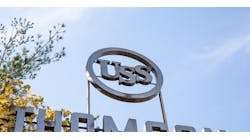Prescription for Survival: How to Control Healthcare Costs
When the packages arrive daily at Ottawa Dental Laboratory, a big crowd gathers around the mailroom. It's not the latest production equipment that's got the employees of this dental device manufacturer so curious; rather, it's the anticipation of a big-screen TV, iPod or Weber grill that one of them will get to take home. And what type of extra commitment do these employees have to make if they want to be eligible for a prize? They have to commit to their own health.
In a program called Vitality Bucks rewards, which has an impressive 98% participation rate, Ottawa Dental Lab employees are on a daily quest to take charge of their health. "It's not as easy it sounds," explains Joanie Bretag, vice president of HR at the Ottawa, Ill.-based company. "We have precise goals that are set up based on test results and a specific time frame to meet these goals. It's what everyone talks about around here."
The gift incentives are an integral part of a health journey that the company has embarked on. The Vitality Wellness and Incentive Program, which was created by Destiny Health, gives employees redeemable Bucks' for each test, each health program and every measurable improvement.
For more information on this topic including the National Business Group on Health Awards for 2007 click here. |
The company also is experiencing cohesiveness among its employees. "We all have this very strong common bond of getting healthier. We ask each other for advice on how to achieve goals, regardless of job titles," says Bretag.
"Sustainability" Refers to People, Too
An integrated approach to a healthier workforce is the hallmark of chemical giant Dow Chemical Co.'s strategy, as well. Setting a specific goal of reducing the health risks of its global employee population by 10% by 2015, Dow is introducing healthcare into its performance management requirements.
Beginning in January 2008, eight sites across the company will implement a Healthy Workplace Index as part of its business goals, says Gary Billotti, Health Strategy Implementation leader for Dow. The program is a joint responsibility between the site leadership team, the responsible healthcare leader and the occupational health and industrial hygiene functions. The concept of having healthcare as a shared responsibility is part of Dow's sustainability goals, Billotti adds.
Like Dow, Ford Motor Co.'s healthcare strategy is focused on prevention. While most companies ask employees to take a health risk assessment, which is a primary tool to measure the risk of certain diseases, Ford encourages its employees to take a personal health assessment. "Changing the focus from treating diseases to asking employees to become engaged in the process of preventing diseases is a different take on healthcare. "We want to help employees maintain and improve their health, not just help them manage their diseases," says Emmanuel Curry, Ford's senior healthcare analyst.
Ford's program, called the Healthy Highway, began in March 2007. Its tag line -- "Good Health isn't Automatic, it's Manual" -- has struck a chord among its early adopters. Feedback has been positive, says Curry.
The Personal Touch
"Everyone needs to understand the financial stakes that are involved with healthcare," says Joe Gregor, president and general manager of healthcare provider Cigna HealthCare's Great Lakes Region. "Senior managers must be involved in frank communication to convey the message that there is a big cost problem out there and we have to do something about it. It affects a company's ability to compete."
Gregor feels that the health risk assessments are still the best tool for companies to get a baseline of their workforces' health situation. It is the starting point for deciding which programs the employees need and the basis for an ongoing communication program with the workforce. Cigna offers a variety of tools for employees to improve their health, including a "High Touch Personal Assistance" with a Cigna health adviser who can proactively identify and reach out to employees who are risk for health issues but are not yet involved with chronic-case management programs.
Reaching out directly to employees is a tactic that has worked well for Victaulic Co., a piping products manufacturer based in Easton, Pa. Every four to six weeks wellness coaches personally visit employees at the workplace. "These coaches know our employees and can deliver the message to each of our employee groups in a way that makes sense for their work environment," says Maryellin Treacy, corporate manager of compensation and benefits.
The personal touch is working as the program, run by Wellness Coaches USA, has a 98% participation rate. At Victaulic half of the employees work in the foundry and the rest work at manufacturing plants.
In deciding on what type of program would work best, Victaulic's senior management realized that while they need to address the current health conditions of the population, they must also speak to the younger employees who currently do not have health issues but could in the future. To create a healthy atmosphere the company designed a walking path for employees and encouraged "walking lunches."
The company also sponsored a "Biggest Loser" competition, based loosely on the television show. About 25% of the workforce participated and cumulatively lost more than 708 pounds.
Weight loss programs also struck a chord with the 80 employees at Rockford Acromatic Products Co., based in Rockford, Ill., which specializes in custom universal joint and driveline component design and manufacturing for the specialty vehicle and equipment market. In fact, 90% of the workforce participates in its Healthy Weight Management Program. To launch the program, the company devoted two days on educating employees on its benefits. Rockford Acromatic partnered with Tangerine Wellness, which has an Internet-based tracking system that allows participants to follow their weight loss. Small incentives were provided as well.
"A small company can have a large effect on healthcare costs with minimal investment," explains Jim Knutson, risk manager at Rockford Acromatic. "We found an easy-to-use tool accompanied by an easy concept works well across our entire organization, and we are having good results."
Knutson's advice to other small manufacturing companies: "Keep thinking ahead when it comes to these types of programs. By continually adding components you can enhance the program and keep if fresh. And start today. Don't let the perfect be the enemy of the good.' Plan, yes, but put a program in place so you can make a difference fairly quickly."
Wellness as a Way of Life
Making a difference in an employee's life was the driving force for the Healthyroads Program that Polaris Industries Inc. put in place. Hoping to educate employees on how their lifestyle choices led directly to the state of their health and the cost of healthcare, Polaris, a Medina, Minn.-based manufacturer of snowmobiles and all-terrain vehicles, offered employees personal health coaches. And not just for a few sessions -- employees are entitled to as many as 56 coaching sessions a year.
Two years into the program, Polaris has managed to keep its insurance cost increases below the national average. "That's been a big achievement for us," explains Shannon Knotts, manager of employee compensation. "Four years ago we were at double the national average in terms of costs. We turned it around through a supportive management team combined with putting the right programs in place."
Finding the right program is easier once the problem is identified. Just ask Hess Print Solutions, a commercial printer. "We learned that 50% of patients leave their doctor's office without knowing what they are supposed to be doing. Additionally, employees see a variety of doctors, have various procedures and end up not being able to efficiently navigate the healthcare system," says Kara Trott, CEO of Quantum Health Inc., who worked with Hess to create an integrated health management system.
on-site walking path in Texas.
Similarly, lift truck manufacturer Crown Equipment Corp., based in New Bremen, Ohio, has seen marked results from its HealthWise Program. After four years and a participation rate of 92%, more than half of Crown's workforce is in the "low health risk" category, which represents a 12% improvement.
"The HealthWise Program has done exactly what we had hoped," says Dr. James Heap, Crown's corporate medical director. "We significantly increased the number of low-risk employees and reduced the number at high risk." Crown's benefits, he says, from having healthier employees include increased productivity, fewer injuries and lower medical costs. "We feel HealthWise definitely gives us a competitive edge in our business."
A good corporate healthcare profile can also translate into a recruiting tool. "Our approach to healthcare is based on our overall culture going back 20 years, when the founders of the company built a fitness center," says Kay Cooke, benefits director at Worthington Industries, a metal processing company based in Columbus, Ohio. "Looking to 2008 we are implementing a wellness champion program where each plant will find a person with a passion for wellness and ask them to carry out the programs, while earning wellness credits for work they do."
Employees at Worthington are participating in a wellness program called Healthy Choices that has helped them lose weight, detect diseases early and improve morale. They pay nothing in monthly premiums for the program, and what's more, employees may be given additional funds toward their chosen healthcare plans. These funds can be used for dental and vision insurance or other wellness programs. With a 65% participation rate, and a 2.15 to 1 return on investment, the company is happy as well. In 2006 its healthcare costs increased a mere 2.15%.
Worthington's results seem to align with the results of a Hewitt study, which found that in 2007 48% of employers offer or planned to offer incentives to employees who participate in wellness or other health-related initiatives, compared with 38% in 2006.
And further encouragement could come from the U.S. government through the introduction of the Healthy Workforce Act. Introduced on July 9, 2007, by Senators Tom Harkin, D-Iowa, and Gordon Smith, R-Ore., the act would provide tax incentives to companies that establish comprehensive wellness programs for their employees.
Under the act, companies that spend $400 per employee on wellness earn a tax credit of up to $200 per employee for the first 200 employees and $100 per employee for the rest of the payroll. In order to qualify, a company would have to institute an initiative that has three of the following components: a health awareness and education program; a behavioral change program; an employee engagement committee; and incentives for participation, such as a reduction in health premiums.
For more information on this topic including the National Business Group on Health Awards for 2007 visit www.industryweek.com/workplacehealthprograms.




